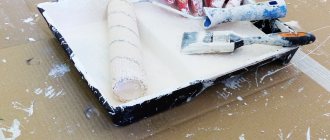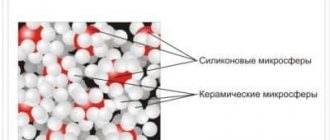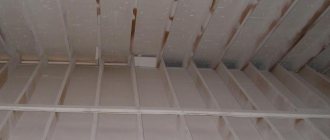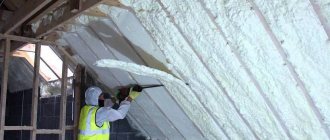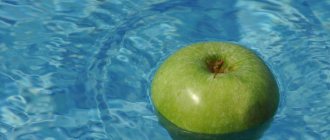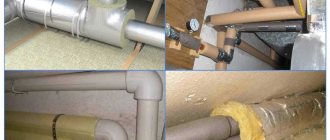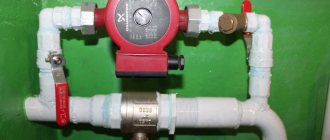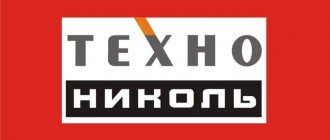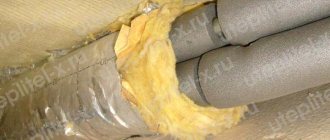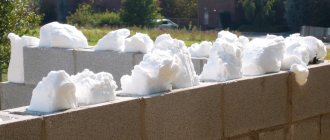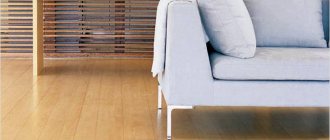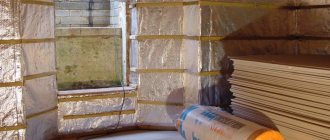Thermal insulation Bronya is a modern material for insulating objects for various purposes. In structure and method of application, the substance resembles paint. On the market you can find products with similar properties: Asstratek and Corundum. Unlike other types of thermal insulation, Bronya brand paint will not hide space. According to its characteristics, a thin layer can replace a mineral wool slab up to 50 mm thick.
Tips for applying insulation
Before coating any surface, you must thoroughly clean it of dirt, oil stains, fill up potholes and cracks, and then wait until it dries completely.
All this will significantly increase the adhesion of Bronya thermal insulation to the material. The paint is applied using a roller, brush or airless spray. The average drying time is 24 hours. It is recommended to apply a layer of no more than 6 mm, since a larger amount will not affect the thermal insulation properties. Water is added to the suspension only in extreme cases, for example, during long-term storage. Average consumption is 1 liter of Bronya insulation per 1 m2 (with a layer 1 mm thick). The amount of insulation required will vary depending on the surface being painted and the required application density. Judging by the reviews of experts, it is always better to calculate with a reserve, for example, for metal, increase consumption by 5%, concrete - 10%. The temperature of the material to be coated must be in the range from +150 to -35°C. Before use, the thermal insulation should be thoroughly mixed to the same consistency. It is recommended to store only in a hermetically sealed container in a dark room from +40 to -40°C. Transportation is permitted in any way.
Laying technology
The dimensions of most coatings and the non-standard, complex architectural component of modern buildings increasingly make it impossible to effectively use traditional thermal insulation materials both inside and outside. For example, not everyone can thoroughly insulate a curtain wall using mineral wool, especially if the home is located above the second floor.
With the advent of Bronya liquid thermal insulation, the situation has changed dramatically. The substance effectively fills any gaps in structures, creating a coating whose thickness is about 2-3 cm.
Surface preparation
To create a durable, and most importantly, reliable insulating coating, the liquid substance must be applied only after special procedures for preparing the coatings have been completed.
For these purposes, it is recommended to use solvents that have a degreasing effect on surfaces. Finally, it is enough to carefully treat the surfaces with a stiff wire brush.
Application of insulation
The ideal tools for high-quality, effective application of liquid thermal insulation are airless sprayers and soft brushes. During the application of the preliminary layer, no more than 1 mm of the substance is laid. The use of a step-by-step economical approach promotes optimal consumption of thermal insulation, eliminating the formation of layers.
Ultra-thin liquid ceramic thermal insulation coating “Armor”
Liquid thermal insulation Bronya Classic/Classic NG from 410 rub/l Liquid thermal insulation Bronya Facade/Facade NG from 440 rub/l Liquid thermal insulation Bronya Anticor/Anticor NG from 480 rub/l Liquid thermal insulation Bronya Standard/Standard NG from 374 rub/l Liquid thermal insulation Bronya Wall/Wall NG from 335 rub/l Liquid thermal insulation Bronya Metal/Metal NG from 365 rub/l Liquid thermal insulation Bronya Winter/Winter NG from 450 rub/l Liquid thermal insulation Bronya Nord/Nord NG from 389 rub/l Thermal insulation putty Bronya Light /Light NG from 253 RUR/l Liquid thermal insulation Bronya Universal/Universal NG from 305 RUR/l Liquid thermal insulation Bronya Anti-condensate 565 RUR/l
What is Bronya liquid thermal insulation?
Liquid thermal insulation Bronya is a suspension that looks like acrylic paint, which can be applied to the surface of concrete, brick, wood, plastic, metal with a regular brush, spatula or airless spray machine. After the material has completely dried, a coating is formed that, compared to other types of insulation, has unique thermal insulation properties.
So, just 1 mm of the “Armor” coating corresponds in thermal conductivity to a layer of mineral wool 50-60 mm thick.
The required coating thickness is achieved by layer-by-layer application of the material (1 layer = 0.5 mm).
What can be insulated with Bronya thermal insulation? The Bronya series coatings can be used to thermally insulate building facades, roofs, interior walls, and concrete floors. The material very quickly and easily copes with condensation on plastic windows. Liquid ceramic thermal insulation is the only option for insulating the facades of buildings of architectural and historical value. With Bronya thermal insulation you can completely insulate a balcony or loggia simply by painting the walls from the inside. Bronya coatings also thermally insulate boilers, pipelines (hot and cold water supply), heating mains, steam pipelines, air conditioning ducts, cooling systems, various containers and tanks, trailers, refrigerators, vehicles, sea and river vessels. The material is also used to eliminate condensation on cold water supply pipes and reduce heat loss in accordance with SNiP in heating systems. Recently, HOAs have begun to use the material very often to combat the formation of icicles on the roofs of apartment buildings.
Why choose Bronya liquid thermal insulation?
The quality and reliability of Bronya coatings were appreciated by consumers in all regions of our country from Kaliningrad to Sakhalin and from Sochi to Murmansk. Bronya liquid thermal insulation is also represented by distribution centers in Belgium, Hungary, Serbia, the Czech Republic, Bulgaria, Poland, Romania, Belarus, Ukraine, Kazakhstan, Lithuania, Estonia, Latvia, Latin America, South Korea, Vietnam and other countries. Over many years of operation, our company has accumulated invaluable experience, which we are always happy to share with you. Modern production of innovative developments and modifications of Bronya heat insulators, with numerous confirmed tests of all declared physical and thermophysical parameters, an impressive set of certificates, permits and, of course, an unsurpassed team of technical specialists - this is what distinguishes us from numerous “catching up”
| CALCULATE MATERIAL CONSUMPTION FOR YOUR OBJECT |
How to apply thermal insulation paint yourself
As noted above, Bronya thermal insulation can be applied using a sprayer or a regular brush. During the first pass, a protective layer 1 millimeter thick is laid on the treated surface. This is explained not only by the fact that the most rational consumption of the substance will be ensured, but also by the fact that various kinds of layers will not appear.
Note! On average, the operating temperature range ranges from -35 degrees to +150 degrees, although a more specific figure depends on what type of Armor you are using.
Immediately before use, the material is mixed directly in a plastic bucket. In order to achieve the required consistency, a small amount of distilled water is added (this is indicated in the manufacturer's instructions).
Video - Applying liquid thermal insulation Bronya
Application area
Thanks to its excellent characteristics, Bronya insulation is used everywhere. It is used to protect buildings inside and outside. The material is used in the process of insulating communications, insulating wires, etc. The range of application of the mixture is quite wide:
- Protection of vertical and horizontal structural elements of various buildings (floors, walls, ceilings), roofs.
- Possibility of insulating a residential building and large-sized objects, poorly heated premises (hangars, warehouses, workshops).
- Thanks to special additives, the Liquid Armor mixture has anti-corrosion properties and can be used on any metal surfaces.
- Protection of communications of any type from freezing (water supply, sewerage, heating and air conditioning systems, gas and steam pipelines).
- Insulation of the main components of the heating and hot water supply system: boilers, boilers, various types of heat exchangers.
- Oil pipelines that are located below and above soil level.
- This type of thermal insulation is also quite suitable for refrigeration equipment.
- Insulation of water storage facilities and containers for chemical reagents.
- Bronya mixture is used to protect cars (railway, metro) and tanks from heat loss.
- Thermal insulation of ships, boats, yachts and boats (internal surfaces, engine room).
Heat insulator brands
The manufacturer presents several main options for liquid heat insulation.
Armor Anticor
Effective for insulating metal surfaces.
It can be applied directly to materials that contain signs of developing corrosion processes, without pre-treatment with anti-corrosion substances.
Classic
Bronya Classic is a universal insulating substance that is ideal for processing traditional coatings.
Withstands exposure to elevated temperatures up to 200 °C.
Facade
Bronya Facade - reliably insulates rooms from the inside, without interfering with full air circulation, which avoids the appearance of rot and the formation of fungi.
Armor Winter
The mixture allows you to insulate objects at low temperatures down to -35 oC.
Useful tips from the pros
Beginning craftsmen need to carefully study the recommendations of experienced builders who will help complete the work at a high professional level. Current and popular tips for quality work are as follows:
- applying insulation to an uncleaned surface will significantly increase the percentage of construction material consumption;
- to obtain high adhesion rates, the primer and insulation must be purchased from the same brand;
- when mixing a thick solution with distilled water, you must try not to damage the microspheres of the mixture;
- the volume of liquid when diluted should not exceed 5 percent;
- If the humidity in the room is high, the insulation must not be diluted with liquid;
- to increase the level of thermal insulation, it is better to apply several thin layers of coating than one thick one;
- the coating must be applied quickly and carefully;
- applying the next layer is allowed only when the previous one has completely dried;
- Carrying out work in violation of technological norms and rules will lead to low-quality coatings and irrational use of building materials.
For information about the characteristics of Bronya thermal insulation, see the following video:
Advantages and disadvantages
When choosing a material with which you can influence the intensity of heat outflow, it is recommended to study the properties and reviews. To select a suitable option from the coatings offered on the market, you should pay attention to the positive and negative qualities of the product. The advantages of the liquid mixture produced under the Bronya brand include the following properties:
- thin layer of coating;
- versatility;
- ease of use;
- the coating does not lose its properties in extreme cold and heat;
- high efficiency;
- the coating does not weigh down the structure;
- excellent adhesion to different types of surfaces;
- the material is non-hygroscopic;
- resistance to UV radiation;
- subject to repair;
- sufficient level of strength.
The material has many advantages. There is a variety of mixtures of this brand:
- for use in winter;
- plastering compounds, etc.
Various types of products are created to protect objects with different characteristics. This means that each option is suitable for use under certain conditions. A significant level of material efficiency is achieved.
The disadvantages include high cost. You can purchase formulations of various types, which are produced under the Bronya brand, for 350-1000 rubles. The price is for 1 liter of liquid. Despite the fact that the material is allowed to be used at temperatures of -60...+250°C, insulation work can only be carried out if the air temperature is above zero. Recommended conditions: +7…+150°С. If you plan to isolate an object for the winter, it is better to do this long before the onset of frost. Disadvantages include drying time. It is allowed to continue work one day after applying the coating.
Deep penetration primer Bronya Concentrate
Properties:
- strengthens the surface of the base;
- increases adhesion of materials to the base;
- reduces the absorbency of the base;
- has high penetrating ability;
- does not reduce the vapor permeability of the base;
- environmentally friendly.
APPLICATION AREA:
Primer Concentrate is intended for treating absorbent substrates before fixing ceramic and stone tiles, applying plasters, laying self-leveling floor mixtures, etc. for interior and exterior work.
Universal primer is used on walls and floors to treat:
- concrete, cement-sand screeds (including heated screeds);
- cement-sand, cement-lime and lime plasters;
- lightweight and cellular concrete;
- anhydrite screeds and gypsum plasters;
- particle board, wood fiber, plasterboard, cement particle board and other boards;
- masonry made of ceramic and silicate bricks, natural and artificial stone, concrete blocks, etc.
BASE PREPARATION:
The base must be dust free and cleaned of dirt and substances that reduce the adhesion of the primer (fats, lubricating oils, bitumen, glue, paint coatings, etc.). Unstable areas of the base, weakened surface layer, cement laitance must be removed mechanically (grinding or milling). Anhydrite screeds must be sanded until the filler grains appear.
EXECUTION OF WORK:
The primer should be mixed before use. The primer is applied to the base in a thin layer using a brush or roller, avoiding the accumulation of liquid. The primer dries within 4-6 hours (depending on temperature and humidity conditions), after which further work can be carried out. After the primer has dried, the base should be checked for absorbency and, if necessary, re-treated. Tools should be washed with water immediately after use. Dried material can only be removed with a solvent.
RECOMMENDATIONS:
Work should be carried out in dry conditions, at air and base temperatures from +5 to +35C and relative air humidity ≤80%. All quality indicators and recommendations stated in the technical description are correct at an ambient temperature of +20C and a relative air humidity of 60%. In other conditions, it is possible to change the drying time of the primer.
NOTES:
In addition to these instructions, when working with primer, you should be guided by SNiP 3.04.01-87, as well as general instructions for performing construction work. If you are in doubt about the use of a material, you should test it yourself or consult the manufacturer.
STORAGE AND PRECAUTIONS:
The shelf life in dry conditions, on pallets, in original, undamaged packaging is no more than 12 months from the date of manufacture. Protect from freezing! Performers of work must be provided with: special clothing, respirators, rubber gloves, and safety glasses. Do not allow the product to come into contact with the skin, eyes, or respiratory organs. If the mixture gets into your eyes, rinse them with water and seek medical help. Keep out of the reach of children.
SPECIFICATIONS
| Soil composition Concentrate | aqueous dispersion of acrylic copolymers |
| light yellow | |
| Density | about 1.0 kg/dm² |
| Application temperature | from +5 to +35ºС |
| Drying time | 4-6 hours (depending on drying conditions) |
| Soil consumption Concentrate | 0.1-0.2 kg/m2 (0.1-0.2 l/m2) with a single application (depending on the absorbency of the base) |
PREPARATION OF PRIMERS:
For self-preparation of soils: The concentrate must be diluted in the following proportions:
- Facade soil - 1 liter Concentrate: 0.6 liters of water
- Universal primer - 1 liter Concentrate: 0.8 liters of water
- Interior primer - 1 liter Concentrate: 1 liter of water
The color of finished primers can vary from light yellow to light brown
DATE OF MANUFACTURE, LOT NO.:
See packaging date/batch number.
MANUFACTURER'S WARRANTY:
The manufacturer guarantees that the properties of the product comply with the technical specifications indicated on the packaging for 12 months from the date of manufacture, subject to compliance with the rules of transportation, storage and use. The manufacturer is not responsible for non-compliance with the technology when working with the material, as well as for its use for purposes and conditions not provided for in these instructions.
Operating principle
Heat can be transferred in several ways:
- Convection.
- Thermal conductivity.
- Thermal radiation.
Each option is characterized by different principles of heat distribution:
- liquid, gaseous medium
- kinetic energy of the smallest particles
- electromagnetic radiation.
In any of the cases, 2 types of body are involved: one of them is hotter, the other is weaker or completely cold. It is interesting that the insulating material of the Bronya brand to some extent combines 3 methods. The main part of the composition is microspheres filled with rarefied air (80%). The rest of the binder produces heat due to its thermal conductivity property.
The surface receives some of its heat through the process of convection and radiation. Considering that the microspheres contain air, heat loss will be small. This is the most suitable (after vacuum) medium that can be used as an insulator. Due to the low intensity of heat transfer, the material helps maintain the desired temperature of the object.
Certification
Along with full basic certification (Fire certificates, SGR, certificates of conformity), LCD has an expanded certification package:
-Technical Certificate of the Ministry of Construction and Housing and Public Utilities of the Russian Federation, based on the “Technical Assessment of the Federal Autonomous Institution FCS” - the Main highest approval in the field of construction in the Russian Federation (Technical Certificate + Technical Assessment).
-Tests (confirmation of the declared physical properties) in a European laboratory according to standard EN 1504-2 to confirm the declared characteristics in TU 2216-006-09560516-2013. — As a basis for assigning the right to use CE marking.
— confirmation of the declared physical properties in the European laboratory according to the EN 15824 standard, CE certificates for Bronya Classic, Bronya Classic NG, Bronya Facade, Bronya Facade NG, Bronya Zima Bronya Fire Protection.
-Certificate of the Ministry of Regional Development of the Russian Federation, represented by Housing and Municipal Construction Certification, on the inclusion of thermal insulating polymer coating in the official register of technologies, equipment and materials used in the housing and communal services sector of the Russian Federation.
-Certification in the Gazpromsertification system.
-Certificate of conformity in the Mosstroysertifikatsiya system (with the issuance of a separate frame certificate for each modification).
-Certificate of type approval of the Russian Maritime Register of Shipping.
-Certificate of the ISS "NEFTEGAZ ENERGOEXPERT" on inclusion in the register of suppliers of the oil and gas complex.
-Certificate in accordance with GOST R.
-Fire safety certificate.
-Sanitary and epidemiological conclusion.
-Certificate of the fuel and energy complex TEXERT.
-Certificate of the Federal Directory of the Fuel and Energy Complex.
-Ultra-thin thermal insulation Bronya and its production are certified in the ISO 9001:2011 system and can be used in Russia without restrictions.
-Certificate of approval for use in Saudi Arabia.
-Certificate of approval for use in the UAE.
Liquid ultra-thin thermal insulation has undergone laboratory tests of all physical and thermophysical indicators by certified laboratories. In its archive, the regalia has a huge number of official acts, tests and conclusions on successful application from leading enterprises of industry, resource extraction and processing, housing and communal services, municipal unitary enterprises, etc. The production and use of liquid ceramic heat-insulating materials Bronya are protected by patents.
Liquid insulation for work in winter
It differs from other analogues in that it can be applied to the surface at subzero temperatures. This includes brands such as “Akterm Nord”, “Korund Zima”, “Bronya Zima”. Thermal paint "Akterm Nord" retains its properties at a temperature of -300C. A mixture consisting of white spirit and solvent is used as a solvent for this thermal insulation material. Before applying Akterm Nord paint, the surface must be thoroughly cleaned and dried. When working with this material, there are restrictions on surface humidity: for plaster and brick no more than 5%, for concrete 4%. Ambient humidity should not exceed 75-80%. This thermal paint is a water-inactive system. It contains a mass of microgranules that have closed pores. Microgranules are in a solution of silicone-modified resin. Various plasticizers, fungicides and biocides are used as additional components.
What varieties are divided into, features of each type,
The market for insulating coatings in this category offers several varieties, differing in composition and application methods:
- ceramic
- penoizol (expanded polystyrene).
General advantages - speed of coating, good thermal insulation properties. In all other respects, these compositions differ slightly from each other: in scope of use, composition, specific properties.
Ceramic heat paint
In appearance, it is a substance (mastic) reminiscent of an acrylic paint coating. There are several types of this insulation on sale. However, their consistency, technical data and composition are identical:
- The binder is a water-acrylic solution.
- Additional components - silicone resin, rubber or other components with similar properties.
- Ceramic granules of regular round shape.
After application, it forms an ultra-thin layer with very high thermal insulation properties. Widely used in construction. In addition to thermal insulation functions, it is also used as protection against corrosion.
Expanded polystyrene compositions
It also has many names, it depends on the manufacturer and country of manufacture. Comprises:
- Urea-formaldehyde resin, which is also included in the composition of cold-hardening foams.
- Foaming substance.
- Water.
- Orthophosphoric acid.
The percentage of resin is the main indicator of density. To mix the ingredients of the composition, special equipment is used (a gas-liquid apparatus that runs on compressed air). As a result, the components, when mixed, turn into a foamy mass.
Apply by spraying. To do this you will need a special spray bottle. This application technology allows you to densely fill voids, cracks, and crevices. Has a slightly yellowish tint.
Thermal insulation paint can be used to insulate any type of pipe, regardless of its purpose. This approach is reliable protection against: heat loss and corrosion.
Thermal insulation Armor: material characteristics
Bronya liquid thermal insulation is produced by the Volgograd Innovation Resource Center. The material is made from imported raw materials at our own production facilities. As a result, an ultra-thin insulator is sent to consumers, which in appearance and consistency resembles ordinary pure white paint, which acts as an effective and reliable thermal insulator.
- The material retains its properties in temperatures ranging from -60 to + 200 degrees, and short-term temperature exposure can be as high as 260 degrees Celsius.
- The service life of this thermal insulation ranges from 10 to 30 years, depending on operating conditions. The manufacturer provides its own warranty on the material for a period of 1 year.
- All the manufacturer’s materials have passed the necessary certification, and their properties are confirmed by scientific tests.
Thermal insulation Bronya has the following main modifications:
Liquid insulator Bronya Classic is intended for a wide range of applications as thermal insulation of enclosing structures, walls, roofs, balconies and loggias, as well as pipelines for various purposes and designs. The coating is weather-resistant, not affected by temperature changes, does not allow steam and moisture to pass through, and contains substances that suppress the oxidation of metals, that is, prevent corrosion. The material is produced in buckets with a capacity of 5, 10, 20 liters. The weight of a 20-liter container is less than 10 kilograms. Cost – from 300 rubles per 1 liter. When purchasing material in bulk, you can get a 10-20% discount. Bronya Anticor material is designed not only to effectively conserve heat at an object or in a room, but also to stop surface rusting. To apply the insulator, simply brush the surface with a wire brush to remove the surface layer of rust. After this, you can apply Anticorrosive. To increase the effectiveness of the coating and to save money, you can use a primer from the Bronya series before applying the insulator. The material has a thermal conductivity coefficient of 0.012 and a density of 600 kg per cubic meter. The insulation is produced in buckets that have a volume of 5 to 20 liters. The cost of 1 liter of insulation is from 350-360 rubles per liter. Liquid insulation Bronya Facade has all the necessary characteristics of an ideal facade insulator: low thermal conductivity, high density, reliable waterproofing, elimination of condensation. In order to ensure comfort in living quarters and solve the problem of cold walls, a layer of 1-1.5 mm of insulation is sufficient. A layer of 2-2.5 mm will help get rid of internal condensation. A layer of insulation of 2.5-3.5 mm will protect from freezing. An accurate calculation of the layer thickness is made based on the material of the facade and the thickness of the wall itself. So, for example, for a brick wall 250 mm thick, a 2.5 mm layer of insulation will be required, and for a 400 mm thick foam concrete wall, a layer of 1 mm will be sufficient. The consumption of insulation will also be different. In the examples given, it will be 2.75 and 1.1 liters per square meter, respectively. Armor Facade has a high density and can be applied in a layer of 1 mm in one pass with a brush. The insulation is produced in buckets with a capacity of 5 to 20 liters, costing approximately 350 rubles per liter. The material Bronya Zima is unique in that it can be worked with even at low temperatures. Insulation can be applied at -35 degrees. Although hot weather is not a hindrance for this material, you can work with it at + 30
Please note that drying time will increase at low temperatures. If it takes a day for complete drying under normal conditions (+18-22 degrees), then in frosty weather you will have to wait longer
The material is produced in buckets of 10 and 20 liters, it can be transported at sub-zero temperatures and frozen. Such a heat insulator costs from 400 rubles per 1 liter.
Date: September 25, 2022
Composition and properties
Ultra-thin liquid insulation protects metal surfaces from corrosion and helps reduce heat loss from the room. It can be considered a universal option that combines the properties of thermal insulation and paint and varnish materials. Liquid Armor is the result of the development of Russian scientists. The product was presented by the Volgograd Innovation Resource Center. Compound:
- acrylic binder;
- catalysts;
- clamps;
- ceramic microspheres, characterized by ultra-thin walls, they contain rarefied air.
Auxiliary components are special compounds that protect metal structural elements from corrosion, and concrete surfaces from fungus and mold. Bronya insulation has a liquid structure, the consistency resembles paint.
Product color is white. This is ultra-thin thermal insulation. With its help, structural elements made of different materials are protected from heat loss: concrete, metal, etc.
Thanks to the polymer base, the coating becomes elastic after application, which allows it to withstand deformation processes and a small tensile load. Ultra-thin thermal insulation Armor is used as insulation due to the rarefied air that is inside the microspheres. Main characteristics:
- the thermal conductivity coefficient is much lower than that of most analogues and amounts to 0.001 W/(m*C);
- Bronya heat-insulating paint can be used at high and low temperatures: from -60...+250°C;
- does not cause harm to humans, since the composition does not contain highly toxic and volatile compounds;
- fire and explosion safety;
- resistance to aggressive environments, liquid thermal insulation. Armor can come into contact with alkaline mixtures and saline solutions.
Due to its properties, the insulation lasts for a very long time. Its average service life varies from 15 to 30 years. The mixture is called ceramic armor. It can be paint, a liquid mixture, etc., but the structure is the same.
